2015 Summer - New England
|
Time to switch over to the fall migration map--birds are moving south! (The map download is much faster).
|
New England - Summer 2015 (15 Apr - 15 Aug)The continent-wide scale is boring, so zoom in on individual birds to see how they use their breeding ranges over the course of the summer.Move the gray rectangular slider at the bottom of the interactive map to animate the birds' movements.Scroll down for updated commentary on each bird's movements.Artoo (hot pink), 2013 NH juvenile. Belle (red), Martha's Vineyard female(?). Charlie (gold), Fishers Island male. Donovan (lt blue) NH adult male. Edwin (gray) Fishers Island male. Flow (green) Essex, MA, juvenile male. Gundersen (Magenta) Ayers Island, NH - NEW ADULT MALE North Fork Bob (yellow), Long Island adult male. Snowy (orange) Martha's Vineyard, MA, adult female. Staddler (dk. blue) Seabrook, NH - NEW ADULT MALE Wausau (white) Groveton, NH - NEW ADULT MALE Lizzie (burgundy), Bridgewater, NH, NEW JUVENILE Juliet (teal), Tilton, NH, NEW JUVENILE Notes: I think I've got the colors right now, although they may show up differently on different computers. Hover the cursor over a dot to see which bird is which. Click on it for location details You can zoom in and out and move the map around. If you slide a birds marker along its path, you'll see where the other birds were when your bird was wherever you have the marker. You can also use the calendar to see where all the birds were on a given date. Go to Individual Bios |
Updates:
(Scroll up for interactive map)
13 July - 8 August 2015
It was a pretty busy summer. Artoo finally got back to within 20 miles of his nest on the 23rd of July, a full 115 days after he started his first migration north. Now he's down in western Mass.
Snowy and Belle both behaved as they have in past summers, commuting between western Cape Cod, Martha's Vineyard, and in Mattapoiset (Belle) and Nantucket (Snowy). Neither has found "Mr. Right," but Snowy was hanging around some new nest poles on Chappaquiddick, so we have hopes that she might win a territory next spring.
Up in New Hampshire, we had nest failures at two of the nests where we tagged new males (Wausau up north and Gundersen in the Lakes District). We believe both failures were weather related. Staddler, down on the coast fledged at least 1 young. Donovan, tagged in 2013 in Tilton, NH, and his mate fledged 2 young, one of which (Juliet) is now tagged. Art (tagged in 2012 and untagged in 2013) and his mate once again fledged 3 young, one of which (Lizzie) was tagged on 12 August.
16 June 2015
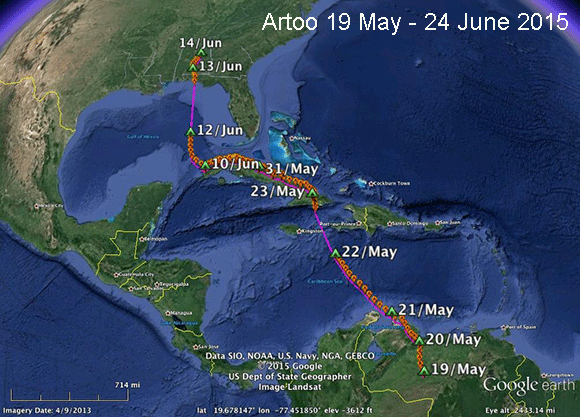 Artoo has set the record for last bird to make it back to the USA on its first migration north. It has been a very strange trip. He left his wintering waters way back on the 31st of March! He made it to the Caribbean for the first time on 21 April. He then retreated to the Venezuelan llanos on the 28th and settled down there for three weeks. He finally rebooted his migration on the 20th of May. No hesitation this time crossing the Caribbean straight to Cuba. He then poked along the spine of Cuba heading northwest. He missed the turn to Florida (many young on their first trip north make this mistake if they went through the Bahamas or over the Atlantic on their first trip south). So he passed Havanna and finally ran out of land on the 12th. Instead of about 100 miles across the Florida Straits, he crossed about 600 miles of the Gulf of Mexico, landing in the Florida Panhandle on the morning of the 13th. While this is the latest any young bird has made it back to the States, he can easily beat the record for latest arrival in his natal area. This ignominious honor is held by Buck, a South Carolinian youngster who, in 2011 got back to South Carolina on April 26th and then wandered almost 9,000 miles around the eastern U.S. before finding his nest area on 13 August! Check out those maps.
Artoo has set the record for last bird to make it back to the USA on its first migration north. It has been a very strange trip. He left his wintering waters way back on the 31st of March! He made it to the Caribbean for the first time on 21 April. He then retreated to the Venezuelan llanos on the 28th and settled down there for three weeks. He finally rebooted his migration on the 20th of May. No hesitation this time crossing the Caribbean straight to Cuba. He then poked along the spine of Cuba heading northwest. He missed the turn to Florida (many young on their first trip north make this mistake if they went through the Bahamas or over the Atlantic on their first trip south). So he passed Havanna and finally ran out of land on the 12th. Instead of about 100 miles across the Florida Straits, he crossed about 600 miles of the Gulf of Mexico, landing in the Florida Panhandle on the morning of the 13th. While this is the latest any young bird has made it back to the States, he can easily beat the record for latest arrival in his natal area. This ignominious honor is held by Buck, a South Carolinian youngster who, in 2011 got back to South Carolina on April 26th and then wandered almost 9,000 miles around the eastern U.S. before finding his nest area on 13 August! Check out those maps.
25 May 2015
Between the 19th and 21st of May, Iain MacLeod and I deployed 3 new transmitters on adult male Ospreys at their nests in New Hamshire.
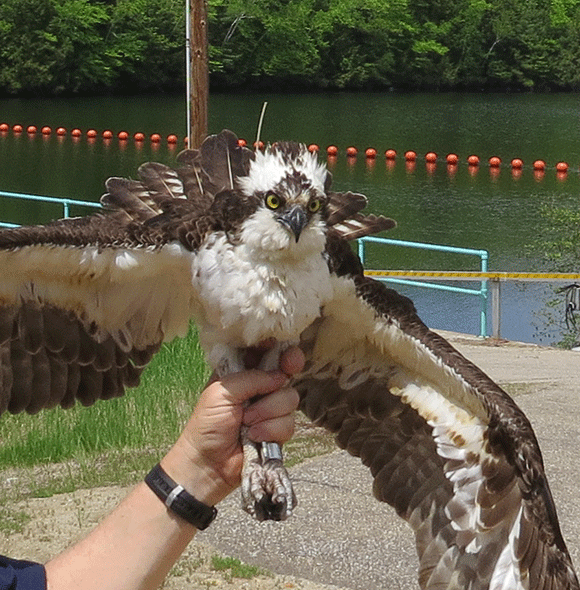 On the 19th we trapped at the Ayers Island Dam near Bristol, NH, in the middle of the state. This nest had been our nemesis. We tried two years to catch the male at this nest but were unsuccessful. This year the trapping went quite smoothly. We caught the female first--as is almost always the case--and held onto her while we waited for the male to take over on the nest. This is the same female we've caught twice before as we tried to trap males at this nest. The male here was named Gundersen in honor of the former manager of the hydroelectric plant. Bob Gundersen was a big fan of the Ospreys and helped out with the old nest-cam that operated here.
On the 19th we trapped at the Ayers Island Dam near Bristol, NH, in the middle of the state. This nest had been our nemesis. We tried two years to catch the male at this nest but were unsuccessful. This year the trapping went quite smoothly. We caught the female first--as is almost always the case--and held onto her while we waited for the male to take over on the nest. This is the same female we've caught twice before as we tried to trap males at this nest. The male here was named Gundersen in honor of the former manager of the hydroelectric plant. Bob Gundersen was a big fan of the Ospreys and helped out with the old nest-cam that operated here.
This is not the male we tried to trap back in 2012. That bird did not return after the 2012-13 migration. In 2013 the ensuing struggle over succession to the nest between at least 3 males was so long and protracted that the female was not able to complete a clutch of eggs and raise young. As soon as the female could lay and egg, the contending males would kick it out of the nest.
On the 20th, we traveled to the north--I mean the Frozen North. The temperature was never over 50 and the wind was howling most of the day. We first tried trapping at a nest right on the Connecticut River in the Fort Hill Gamelands. We trapped Mackenzie there in 2013. We lost him before his started his fall migration to a Goshawk or Great-horned Owl. We were not successful last year when we tried to trap his replacement. This year there's a new female. We banded the previous female in 2012 and could see that the current female does not have a band. The situation at the nest was best described as chaotic. There were 2 or maybe 3 males around, and the female was very skittish, leaving the nest, where she was incubating, frequently as males came and went. After about an hour staking out the nest, it seemed prudent to abandon the effort there and head south to another nest in Groveton, about 6 miles south of the Fort Hill nest.
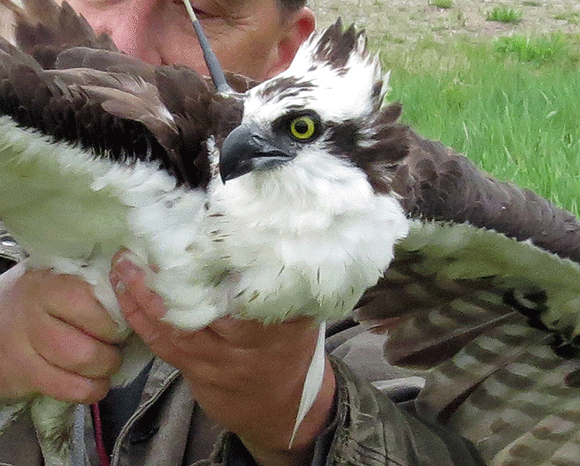 We had tried trapping at this long-established nest in 2014, but the pole, at 65' tall, was just outside the reach of the bucket truck we were using. This year we had a mega-truck and were able to trap our bird in pretty short order. When we arrived, a food transfer had already taken place, so just as we pulled up the female came back into the nest to relieve the male, who had been incubating while the she ate the fish he had delivered. We were concerned that the male might head off somewhere out of sight and thus not been trappable. But, as luck would have it, a Bald Eagle flew by and that got the male's attention. He strafed the eagle a few times and drove it away. We felt that meant our target bird would be attentive around the nest, so up I went up - way up! - in the bucket and set the trap. The female came in quickly and was standing on the noose carpet that I had placed over the nest. The male saw her standing there and landed on her for a quick copulation and then landed on the noose carpet next to her. Unfortunately, he didn't walk around, so he wasn't caught. We did get the female and held on to her for about 30 minutes, when the male came in, landed right on the carpet and was quickly caught. He's named Wausau after the paper company that used to operate a plant at this site.
We had tried trapping at this long-established nest in 2014, but the pole, at 65' tall, was just outside the reach of the bucket truck we were using. This year we had a mega-truck and were able to trap our bird in pretty short order. When we arrived, a food transfer had already taken place, so just as we pulled up the female came back into the nest to relieve the male, who had been incubating while the she ate the fish he had delivered. We were concerned that the male might head off somewhere out of sight and thus not been trappable. But, as luck would have it, a Bald Eagle flew by and that got the male's attention. He strafed the eagle a few times and drove it away. We felt that meant our target bird would be attentive around the nest, so up I went up - way up! - in the bucket and set the trap. The female came in quickly and was standing on the noose carpet that I had placed over the nest. The male saw her standing there and landed on her for a quick copulation and then landed on the noose carpet next to her. Unfortunately, he didn't walk around, so he wasn't caught. We did get the female and held on to her for about 30 minutes, when the male came in, landed right on the carpet and was quickly caught. He's named Wausau after the paper company that used to operate a plant at this site.
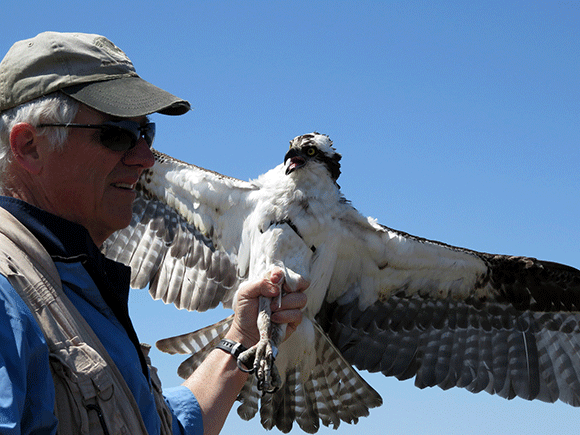 On the 21st we headed down to the NH coastline--all 17 miles of it--with the ambitious hopes of deploying 2 transmitters. We worked the Hampton Beach marshes with the help of Dave Weber, who has set up a number of nesting platforms across the marsh. One of these includes the nest where we tagged a juvenile (Weber) back in 2013. We first checked Weber's nest. The female was incubating and there was a male off in the distance, which might or might not have been the male from that nest. We weren't sure, so we motored off to check out other options. The second nest we checked was just a house-keeping nest--well constructed, but no eggs. So we went on to plan C. The third nest we checked, close to the Seabrook Nuclear Power Plant, had a female incubating and a male in close attendance. When we landed near the nest, the female barely moved. We were almost underneath the nest before she even got up off of the eggs. As we set the noose carpet over the nest, the male showed up and was very aggressive, so we were pretty sure we'd catch him. The female was back on the nest and trapped within minutes of our backing away. Once we had the female in hand (she was a really big bird weighing almost 5 pounds (2.2 kg)), we did not have to wait long for the male to land on the noose carpet and get caught. Within 40 minutes he was released and flying out over the marshes with a new transmitter.
On the 21st we headed down to the NH coastline--all 17 miles of it--with the ambitious hopes of deploying 2 transmitters. We worked the Hampton Beach marshes with the help of Dave Weber, who has set up a number of nesting platforms across the marsh. One of these includes the nest where we tagged a juvenile (Weber) back in 2013. We first checked Weber's nest. The female was incubating and there was a male off in the distance, which might or might not have been the male from that nest. We weren't sure, so we motored off to check out other options. The second nest we checked was just a house-keeping nest--well constructed, but no eggs. So we went on to plan C. The third nest we checked, close to the Seabrook Nuclear Power Plant, had a female incubating and a male in close attendance. When we landed near the nest, the female barely moved. We were almost underneath the nest before she even got up off of the eggs. As we set the noose carpet over the nest, the male showed up and was very aggressive, so we were pretty sure we'd catch him. The female was back on the nest and trapped within minutes of our backing away. Once we had the female in hand (she was a really big bird weighing almost 5 pounds (2.2 kg)), we did not have to wait long for the male to land on the noose carpet and get caught. Within 40 minutes he was released and flying out over the marshes with a new transmitter.
The marshes at Hampton Beach were once harvested for salt-marsh hay. Scattered around the marsh are clusters of wooden stakes. These "staddles" were used to keep the bottom of a pile of hay off the ground so the hay wouldn't rot. They are great perches for Ospreys. Each Osprey pair we visited was using the nearest cluster of staddles as a perch. So we decided to name the newly tagged bird "Staddler." (It was a new word for me, too.)
We tried one more nest--one where the pair was only housekeeping and hadn't laid eggs. We put our dummy eggs in the nest and our noose carpet over the eggs. We caught the female (I wonder what she was thinking when she got to her nest and saw three eggs!) but the male was busy eating a fish (perched on a staddle) and didn't come to the nest. So we left with a PTT still in hand and will deploy it on a youngster this summer.
The day after we tagged Staddler, Artoo, our 2013 juvenile from the Lake District (central NH) finally crossed the Carribean and is now in Cuba. At this rate, by the time he gets home, it will be time to turn around and head south again! Juveniles always come home late (any surprise?), but this is the latest we have had a tagged juvenile still migrating.
Cinco de Maio 2015
There are lots of very interesting things going on in New England this spring.
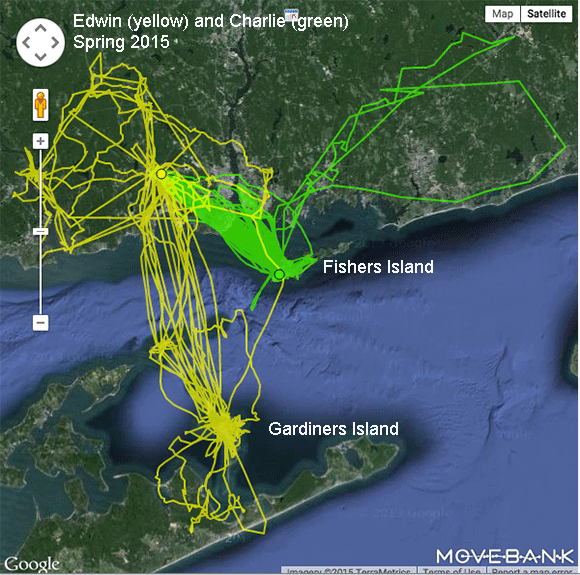 On Fishers Island, Charlie, (green tracks in the map below) after befuddling us with his spring migration detour though the Isthmus of Panama (!), is once again commuting from his nest on the western end of the island to the Thames and Niantic Rivers across Long Island Sound. This was just what he did last year. He made a couple of trips over to Rhode Island and one down to Long Island. All seems to be well at his nest. His former neighbor, Edwin, (yellow tracks above) trapped at his former nest on Fishers Island back in 2013, has completely lost interest in Fishers. He's back wandering around the same broad area of southeastern Connecticut where he spent much of last summer, and is now looking very seriously at some real estate on Gardiners Island. We have long wanted to tag an Osprey at this famous Osprey colony, which from at least 1800 through the 1940s was home to 300 pairs of Ospreys on the 5.6 square mile island! It looks like we may be sneaking in the back door if Edwin can successfully occupy a territory next year. We've seen this process with a number of birds over the year. Especially late in the summer, unmated Ospreys start staking out potential nest sites for the next year.
On Fishers Island, Charlie, (green tracks in the map below) after befuddling us with his spring migration detour though the Isthmus of Panama (!), is once again commuting from his nest on the western end of the island to the Thames and Niantic Rivers across Long Island Sound. This was just what he did last year. He made a couple of trips over to Rhode Island and one down to Long Island. All seems to be well at his nest. His former neighbor, Edwin, (yellow tracks above) trapped at his former nest on Fishers Island back in 2013, has completely lost interest in Fishers. He's back wandering around the same broad area of southeastern Connecticut where he spent much of last summer, and is now looking very seriously at some real estate on Gardiners Island. We have long wanted to tag an Osprey at this famous Osprey colony, which from at least 1800 through the 1940s was home to 300 pairs of Ospreys on the 5.6 square mile island! It looks like we may be sneaking in the back door if Edwin can successfully occupy a territory next year. We've seen this process with a number of birds over the year. Especially late in the summer, unmated Ospreys start staking out potential nest sites for the next year.
Over on the Cape and Vineyeard, Belle is disappointing us again by not finding a hunky bachelor male with a nest. She's commuting back and forth across Buzzards Bay, spending time in the Falmouth area on the Cape and around Mattapoisett on the western shores of the Bay. Belle did spend some time on the Vineyard early in the spring, but she really seems to have lost interest.
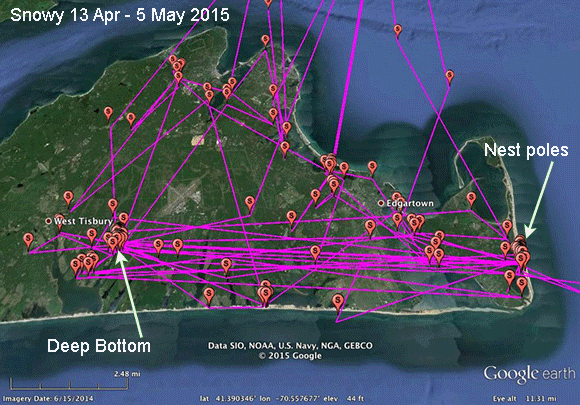 It looks like Snowy, tagged as a juvenile in 2011 a year after Belle, might beat Belle in the nesting race. Snowy, like Belle, is commuting with the southwestern corner of Cape Cod as home base, although she (we think, she's a she) once again is commuting between the Cape and the Vineyard. Most intriguingly, she has become interested in a couple of new nest poles on the Poucha Pond marshes on Chappaquiddick. One of these poles was the one used by DJ who did not return from migration-RIP. (The pole is actually a replacement set in the marsh about 100 yds south of its former location after winter frost heaves popped the pole out of the marsh. There are five or more Ospreys vying for these nest sites. Just like DJ last year, Snowy is commuting from the Chappy nest poles to Deep Bottom, where a herring run gets the attention of the local Ospreys each spring.
It looks like Snowy, tagged as a juvenile in 2011 a year after Belle, might beat Belle in the nesting race. Snowy, like Belle, is commuting with the southwestern corner of Cape Cod as home base, although she (we think, she's a she) once again is commuting between the Cape and the Vineyard. Most intriguingly, she has become interested in a couple of new nest poles on the Poucha Pond marshes on Chappaquiddick. One of these poles was the one used by DJ who did not return from migration-RIP. (The pole is actually a replacement set in the marsh about 100 yds south of its former location after winter frost heaves popped the pole out of the marsh. There are five or more Ospreys vying for these nest sites. Just like DJ last year, Snowy is commuting from the Chappy nest poles to Deep Bottom, where a herring run gets the attention of the local Ospreys each spring.
North-Fork Bob, whose 5-yr old transmitter is going strong, got back to Long Island very late this year and just settled down where he's spent the past couple of summers. He was way too late to nest. It's very perplexing why he hasn't nested.
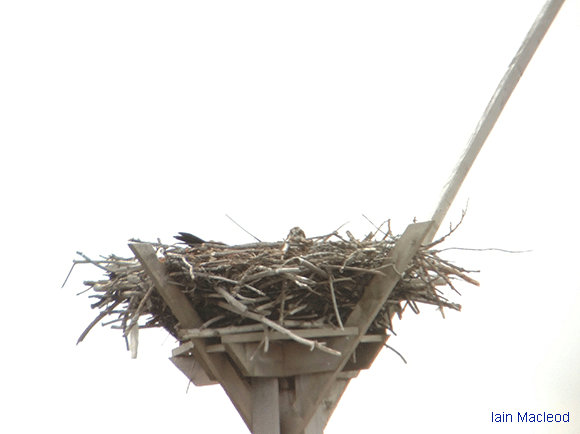 Up in New Hampshire, all is well with Donovan, who's doing his time on the nest when duty calls. New Hampshire "teenager" Artoo left his little bit of the Amazon in late March after his nearly 18 month first stay on the wintering grounds. He seems to have cold feet about crossing the Caribbean again. He got to the northern coast of Venezuela on the Paraguana Peninsula and apparently didn't like the look of nothing but water as far as he could see, so he retreated about 260 miles back into the llanos of Venezuela to a spot he knows has a lot of fish from earlier wandering around.
Up in New Hampshire, all is well with Donovan, who's doing his time on the nest when duty calls. New Hampshire "teenager" Artoo left his little bit of the Amazon in late March after his nearly 18 month first stay on the wintering grounds. He seems to have cold feet about crossing the Caribbean again. He got to the northern coast of Venezuela on the Paraguana Peninsula and apparently didn't like the look of nothing but water as far as he could see, so he retreated about 260 miles back into the llanos of Venezuela to a spot he knows has a lot of fish from earlier wandering around.
I just heard from my colleague Bob Kennedy that Sr. Bones is back on his nest, still wearing his transmitter. Bones was tagged in 2010--the same year as Belle and North-Fork Bob. Bones' transmitter went quiet in the fall of 2013. Belle's and Bob's transmitters are still on the air (obviously).
